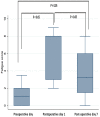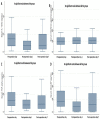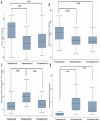Association between Interleukin-6 Levels and Perioperative Fatigue in Gastric Adenocarcinoma Patients
- PMID: 31010015
- PMCID: PMC6518263
- DOI: 10.3390/jcm8040543
Association between Interleukin-6 Levels and Perioperative Fatigue in Gastric Adenocarcinoma Patients
Abstract
Background: Gastric adenocarcinoma (GA), one of the most common gastrointestinal cancers worldwide, is often accompanied by cancer cachexia in the advanced stage owing to malnutrition and cancer-related symptoms. Although resection is the most effective curative procedure for GA patients, it may cause perioperative fatigue, worsening the extent of cancer cachexia. Although the relationship between cytokines and cancer fatigue has been evaluated, it is unclear which cytokines are associated with fatigue in GA patients. Therefore, this study aimed to investigate whether the changes in cytokine levels were associated with the perioperative changes in fatigue amongst GA patients.
Methods: We included GA patients undergoing gastric surgery in a single academic medical center between June 2017 and December 2018. Fatigue-related questionnaires, serum cytokine levels (interferon-gamma, interleukin (IL)-1, IL-2, IL-5, IL-6, IL-12 p70, tumor necrosis factor-alpha, and granulocyte-macrophage colony-stimulating factor), and biochemistry profiles (albumin, prealbumin, C-reactive protein, and white blood cell counts) were assessed at three time points (preoperative day 0 (POD 0), post-operative day 1 (POD 1), and postoperative day 7 (POD 7)). We used the Brief Fatigue Inventory-Taiwan Form to assess the extent of fatigue. The change in fatigue scores among the three time points, as an independent variable, was adjusted for clinicopathologic characteristics, malnutrition risk, and cancer stages.
Results: A total of 34 patients were included for analysis, including 12 female and 22 male patients. The mean age was 68.9 years. The mean score for fatigue on POD 0, POD 1, and POD 7 was 1.7, 6.2, and 3.6, respectively, with significant differences among the three time points (P < 0.001). Among the cytokines, only IL-6 was significantly elevated from POD 0 to POD 1. In the regression model, the change in IL-6 levels between POD 0 and POD 1 (coefficients = 0.01 for every 1 pg/mL increment; 95% confidence interval: 0.01-0.02; P = 0.037) and high malnutrition risk (coefficients = 2.80; 95% confidence interval: 1.45-3.52; P = 0.041) were significantly associated with changes in fatigue scores.
Conclusions: The perioperative changes in plasma IL-6 levels are positively associated with changes in the fatigue scores of GA patients undergoing gastric surgery. Targeting the IL-6 signaling cascade or new fatigue-targeting medications may attenuate perioperative fatigue, and further clinical studies should be designed to validate this hypothesis.
Keywords: cachexia; cancer fatigue; cytokines; gastrectomy; gastric cancer.
Conflict of interest statement
The authors declare no conflict of interest.
Figures






Similar articles
-
Perioperative sargramostim (recombinant human GM-CSF) induces an increase in the level of soluble VEGFR1 in colon cancer patients undergoing minimally invasive surgery.Eur J Surg Oncol. 2007 Dec;33(10):1169-76. doi: 10.1016/j.ejso.2007.03.014. Epub 2007 May 18. Eur J Surg Oncol. 2007. PMID: 17512160 Clinical Trial.
-
Perioperative GMCSF limits the proangiogenic plasma protein changes associated with colorectal cancer resection.Eur J Surg Oncol. 2009 Mar;35(3):295-301. doi: 10.1016/j.ejso.2008.07.012. Epub 2008 Sep 7. Eur J Surg Oncol. 2009. PMID: 18782657 Clinical Trial.
-
Younger age is associated with greater early neurocognitive decline postcardiopulmonary bypass.JTCVS Open. 2020 Mar 6;1:1-9. doi: 10.1016/j.xjon.2020.02.001. eCollection 2020 Mar. JTCVS Open. 2020. PMID: 36445369 Free PMC article.
-
Factors affecting serum albumin in the perioperative period of colorectal surgery: a retrospective study.BMC Res Notes. 2015 Nov 3;8:638. doi: 10.1186/s13104-015-1632-8. BMC Res Notes. 2015. PMID: 26530188 Free PMC article.
-
Prospective randomized controlled study on the effects of perioperative administration of a neutrophil elastase inhibitor to patients undergoing video-assisted thoracoscopic surgery for thoracic esophageal cancer.Dis Esophagus. 2010 May;23(4):329-39. doi: 10.1111/j.1442-2050.2009.01010.x. Epub 2009 Sep 25. Dis Esophagus. 2010. PMID: 19788440 Clinical Trial.
Cited by
-
New intervention strategy for postoperative fatigue syndrome in elderly patients with colorectal cancer: a clinical hypothesis study based on vagus nerve stimulation.Front Med (Lausanne). 2025 Jun 2;12:1588850. doi: 10.3389/fmed.2025.1588850. eCollection 2025. Front Med (Lausanne). 2025. PMID: 40529134 Free PMC article.
-
Platelet detection as a new liquid biopsy tool for human cancers.Front Oncol. 2022 Sep 14;12:983724. doi: 10.3389/fonc.2022.983724. eCollection 2022. Front Oncol. 2022. PMID: 36185270 Free PMC article. Review.
-
Clinical Value of Cytokine Assay in Diagnosis and Severity Assessment of Lung Cancer.Evid Based Complement Alternat Med. 2022 Aug 9;2022:4641600. doi: 10.1155/2022/4641600. eCollection 2022. Evid Based Complement Alternat Med. 2022. Retraction in: Evid Based Complement Alternat Med. 2023 Jun 21;2023:9812186. doi: 10.1155/2023/9812186. PMID: 35982995 Free PMC article. Retracted.
-
Platinum Accumulation and Cancer-Related Fatigue, Correlation With IL-8, TNF-α and Hemocytes.Front Pharmacol. 2021 Sep 7;12:658792. doi: 10.3389/fphar.2021.658792. eCollection 2021. Front Pharmacol. 2021. PMID: 34557089 Free PMC article.
-
Utility of Inflammatory Markers in Detection of Perioperative Morbidity After Laparoscopic Sleeve Gastrectomy, Laparoscopic Roux-en-Y Gastric Bypass, and One-Anastomosis Gastric Bypass-Multicenter Study.Obes Surg. 2020 Aug;30(8):2971-2979. doi: 10.1007/s11695-020-04636-8. Obes Surg. 2020. PMID: 32347517 Free PMC article.
References
-
- WHO Globocan 2012: Estimated Cancer Incidence, Mortality and Prevalence Worldwide in 2012. [(accessed on 21 June 2012)]; Available online: http://globocan.iarc.fr/Default.aspx.
LinkOut - more resources
Full Text Sources
Research Materials

